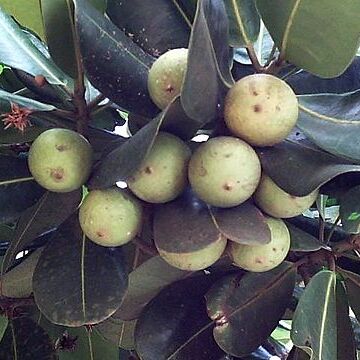Trees [shrubs]. Stems not armed, glabrate or hairy. Leaves persistent, alternate; stipules caducous; petiole present; blade: base rounded, cuneate, or attenuate, apex rounded, retuse, acute, or acuminate to cuspidate, surfaces glabrous or glabrate [hairy] abaxially, usually glabrous adaxially. Inflorescences fascicles or solitary flowers. Flowers: sepals 8 in 2 whorls of 4, outer valvate, larger, inner imbricate, [glabrate] densely hairy abaxially; petals (7-)8, white to yellow or pink, glabrous or hairy, lobes longer than corolla tube, each divided into 1 median and 2 lateral segments, median segment equaling or longer than laterals; stamens (7-)8, distinct distal to corolla tube; staminodes (7-)8, alternating with stamens, inflexed, petaloid, lanceolate, hairy; pistil (7-)8-carpellate; ovary (7-)8-locular, hairy; placentation basal or basiventral. Berries yellow to orange, subglobose, [glabrous] glabrate. Seeds 1[-6], [buff] brown to black, laterally compressed; hilum circular [elliptic]; embryo vertical; endosperm present. x = 12.
Staminodes 8, alternating with stamens, triangular, dorsally and marginally pilose, bending into the centre of the flower to form a conical sheath round the gynoecium.
Seeds ± ellipsoid, laterally compressed, with hard, highly polished testa; scar small, subcircular, basal or basi–lateral; endosperm abundant, cotyledons thin.
Corolla of 8 members joined in a short tube; each member comprising a median and two lateral segments, the latter usually entire, sometimes further divided.
Ovary shortly cylindrical or subglobose, ribbed, 8–locular, densely brownish appressed–pubescent; style cylindrical, ± truncate.
Sepals 8, in two slightly dissimilar whorls of 4, ± free; inner sepals smaller and paler than outer, and with ciliate margins.
Leaves exstipulate (or stipules soon caducous), thinly to strongly coriaceous, not clustered at ends of branches.
Fruits baccate, fleshy to ± coriaceous, sometimes edible, 1–several–seeded, with persistent calyx at base.
Stamens 8, opposing median segments, adnate to corolla tube; anthers extrorse, apiculate.
Flowers borne in axils of current leaves, pedicellate.
Trees and shrubs.

